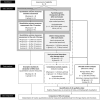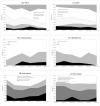Common mental disorders in Gestalt therapy treatment: a multiple case study comparing patients with moderate and low integrated personality structures
- PMID: 38173855
- PMCID: PMC10761483
- DOI: 10.3389/fpsyg.2023.1304726
Common mental disorders in Gestalt therapy treatment: a multiple case study comparing patients with moderate and low integrated personality structures
Abstract
Introduction: Empowerment is central to self-development and growth in Gestalt therapy. The self evolves through interactions with others, forming self- and object-relations, and ego-functions. Underlying structural functions build the ability to regulate, differentiate, and integrate experiences, leading to self-, and emotion-regulation. Our study examined the self-development of seven clients with prevalent mental health issues and structural challenges, all of whom underwent 30 sessions of Gestalt therapy in a real-world individual therapy context.
Methods: Using a multiple case study approach, we contrasted two client groups: those with moderately integrated and those with low-integrated personality structures, as defined by the operationalised psychodynamic diagnostic manual. Our exploration centered on specific factors of empowerment, therapy processes, and interventions. The study's mixed-method design encompassed quantitative outcome measures (empowerment, wellbeing, psychosocial health, and severity of personality functioning), therapy diaries from both clients and therapists, and semi-structured client interviews about empowering factors in therapy.
Results: Both groups showed positive therapy outcomes on wellbeing, psychosocial health, and empowerment. Specific empowerment-related factors included promoting experiences, relationships, and self-efficacy in the low-integrated group. Support of self-regulation was reported to be essential for successful outcomes in the moderately integrated group. While the therapy processes proceeded similarly in both groups, we observed a strong focus on body awareness-oriented interventions and promotion of verbalisation in the low-integrated group and a relationship-oriented emphasis in the moderately integrated group. Emotional experience linked to positive experience was limited in the low-integrated group, suggesting an impairment of emotional processing, including bodily felt feelings. No change was reported in the level of personality functioning after 30 sessions in both groups.
Discussion: These results underscore the need for tailored therapeutic approaches based on the client's level of personality integration. Future research should probe the long-term effects of therapy and delve deeper into shifts in personality functioning, especially concerning emotional and bodily experiences. In practical terms, therapists should prioritize linking bodily sensations with emotions for clients with low-integrated personalities. For those with moderate integration, the emphasis should be on fostering exploration, awareness, and bolstering self-regulation.
Keywords: Gestalt therapy; common mental health disorders; mixed-methods case study; operationalized psychodynamic diagnostic; outcome; process; psychotherapy.
Copyright © 2023 Kaisler, Fede, Diltsch, Probst and Schaffler.
Conflict of interest statement
The authors declare that the research was conducted in the absence of any commercial or financial relationships that could be construed as a potential conflict of interest.
Figures





References
-
- Bacal H. A., Newman K. M., Vorspohl E. (1994). Objektbeziehungstheorien: Brücken zur Selbstpsychologie. Kraichtal: Friedrich Frommann Verlag Gunther Holzboog.
-
- Bargghaan D., Harfst T., Dirmaier J., Koch U., Schulz U. (2002). Bericht einer externen Evaluation und Qualitätssicherung der Hardtwaldklinik I, Bad Zwesten, Abteilung Psychotherapie und Psychosomatik. Nr. 1 Analyse von Struktur, Prozess und Outcome 2000–2001. Universitätsklinikum Hamburg-Eppendorf (Hamburg).
LinkOut - more resources
Full Text Sources

